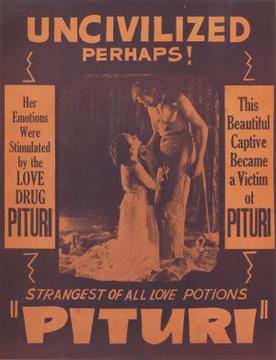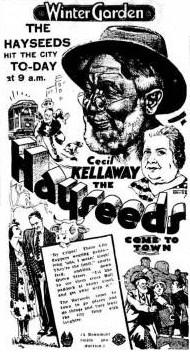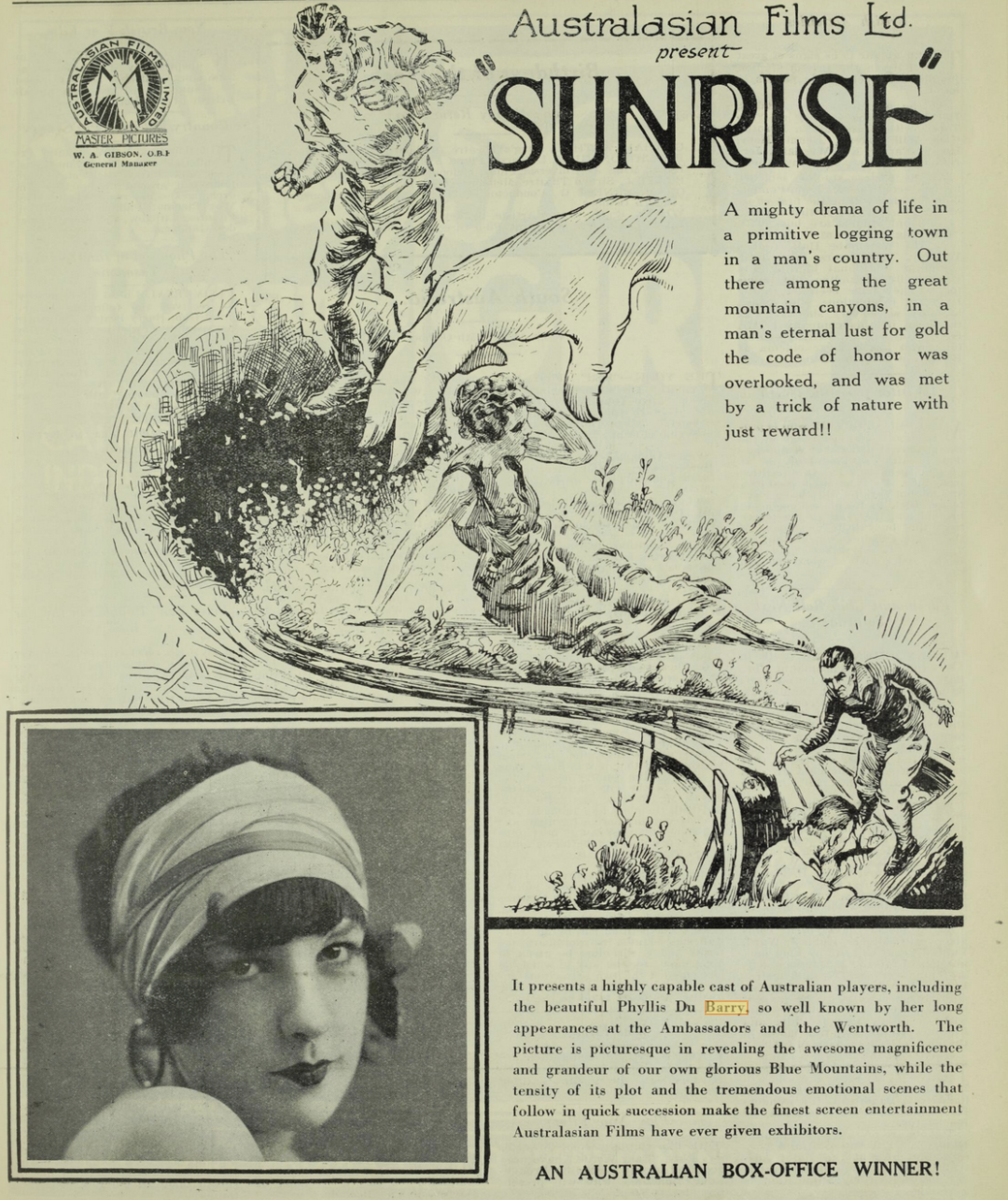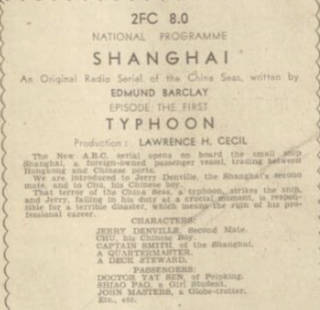Related Research Articles

John F. Gavin was a pioneer Australian film actor and director, one of the early filmmakers of the 1910s. He is best known for making films about bushrangers such as Captain Thunderbolt, Captain Moonlite, Ben Hall and Frank Gardiner. Known informally as 'Jack', Gavin worked in collaboration with his wife Agnes, who scripted many of his films.

Uncivilised is a 1936 Australian film directed by Charles Chauvel. It was an attempt by Chauvel to make a more obviously commercial film, and was clearly influenced by Tarzan.

The Hayseeds is a 1933 Australian musical comedy from Beaumont Smith. It centres on the rural family, the Hayseeds, about whom Smith had previously made six silent films, starting with Our Friends, the Hayseeds (1917). He retired from directing in 1925 but decided to revive the series in the wake of the box office success of On Our Selection (1932). It was the first starring role in a movie for stage actor Cecil Kellaway.

The Martyrdom of Nurse Cavell is a 1916 Australian silent film about the execution of nurse Edith Cavell during World War I.

The Bushwhackers is a 1925 Australian silent film directed by Raymond Longford loosely based on Alfred Tennyson's 1864 poem Enoch Arden. It is considered a lost film.

Sunrise is a 1927 Australian silent film co-directed by Raymond Longford, who took over during filming.
The Russell Affair is a 1928 Australian silent film directed by P. J. Ramster. It was Ramster's last film.
The Menace is a 1928 Australian silent film about the drug trade in Sydney. It is considered a lost film.
The Miner's Daughter is a 1927 Australian silent film set in Sydney and Bendigo. Little is known about it and it is considered a lost film.
Environment is a 1927 Australian silent film about a woman who poses for a revealing painting. It was one of two films produced by Vaughan C. Marshall, the other one being Caught in the Net (1928).
Those Who Love is a 1926 silent film, produced in Australia, about the son of a knight who falls in love with a dancer. Only part of the film survives today and it is held by the National Film and Sound Archive.
The Tenth Straw is a 1926 Australian silent film heavily inspired by the novel For the Term of His Natural Life. Little is known of the director and cast, but most of the film survives today.
Painted Daughters is a 1925 Australian silent film directed F. Stuart-Whyte. Only part of it survives today.

The Life Story of John Lee, or the Man They Could Not Hang is a 1912 Australian silent film based on a stage play about the true life story of John Babbacombe Lee.

The Life Story of John Lee, or the Man They Could Not Hang is a 1921 Australian silent film based on the true life story of John Babbacombe Lee. It is a remake of a 1912 film with some extra scenes of Lee's childhood.

Jessica Harcourt (1905–1988) was an Australian mannequin, author and actress, best known for playing a leading role in For the Term of His Natural Life (1927).
Australasian Films, full name Union Theatres and Australasian Films, was an Australian film distribution and production company formed in 1913 that was wound up in the 1930s to merge into Greater Union. The Union Theatres and Australasian Films dominated cinema in Australia in the 1910s and 1920s.

Shanghai is a 1936 radio serial by Edmund Barclay. It ran for 26 weeks.
Dead or Alive is an Australian radio serial by Edmund Barclay. The series was a follow up to Barclay's successful serial Khyber.
The Unsleeping Eye is a 1928 British film written and directed by Alexander MacDonald. It was filmed on location in Papua.
References
- ↑ "CINESOUND PRODUCTIONS". The Sydney Morning Herald . National Library of Australia. 6 August 1934. p. 5. Retrieved 6 August 2012.
- ↑ "Australian Artists Get Chance". Daily Telegraph (Sydney, NSW : 1883 - 1930). 22 May 1927. p. 32. Retrieved 22 August 2020.
- ↑ "Likely to be Biggest Australian Release in 1928—" The Adorable Outcast."", Everyones., 7 (406 (14 December 1927)), Sydney: Everyones Ltd, nla.obj-578957495, retrieved 2 March 2024– via Trove
- ↑ Andrew Pike and Ross Cooper, Australian Film 1900–1977: A Guide to Feature Film Production, Melbourne: Oxford University Press, 1998, 144.
- ↑ "DAWN IN THE SOUTH SEAS", The Home: An Australian Quarterly, 8 (10), Sydney: Art in Australia, 1 October 1927, nla.obj-385222268, retrieved 2 March 2024– via Trove
- ↑ "Mr. Compton Coutts". The Argus . Melbourne: National Library of Australia. 4 February 1935. p. 8. Retrieved 6 August 2012.
- ↑ "MOVIE WORK IN FIJI." Sunday Times (Perth) 26 Jun 1927: 34 accessed 6 December 2011
- ↑ "ROMANCE ISLE. FILM ACTORS IN FIJI." The Brisbane Courier (Qld) 30 Jul 1927: 11 accessed 6 December 2011
- ↑ "CLAMOUR OF THE SOUTH SEAS." Examiner (Launceston, Tas) 23 Jul 1927: 7 accessed 6 December 2011
- ↑ "FILM COMPANY". The Sydney Morning Herald . National Library of Australia. 15 July 1927. p. 16. Retrieved 6 August 2012.
- ↑ "TO MAKE A MOVIE". Labor Daily (Sydney, NSW : 1924 - 1938). 2 May 1927. p. 6. Retrieved 22 August 2020.
- ↑ Graham Shirley and Brian Adams, Australian Cinema: The First Eighty Years, Currency Press, 1989 p93
- ↑ "Why Australian Films Are Failures". The Mail . Adelaide: National Library of Australia. 5 October 1929. p. 14. Retrieved 4 August 2012.
- ↑ "Title Details; Title no: 125; Title: The Adorable Outcast : Original Release". National Film and Sound Archive. Retrieved 23 February 2013.
- ↑ The Adorable Outcast at silentera.com